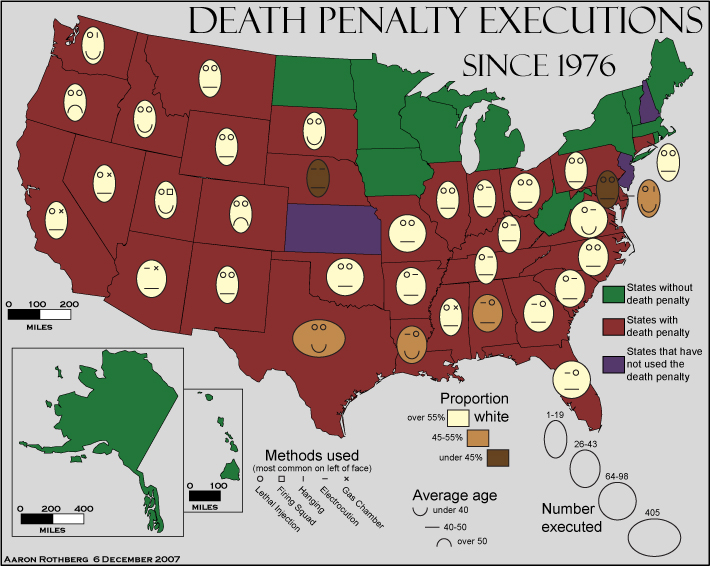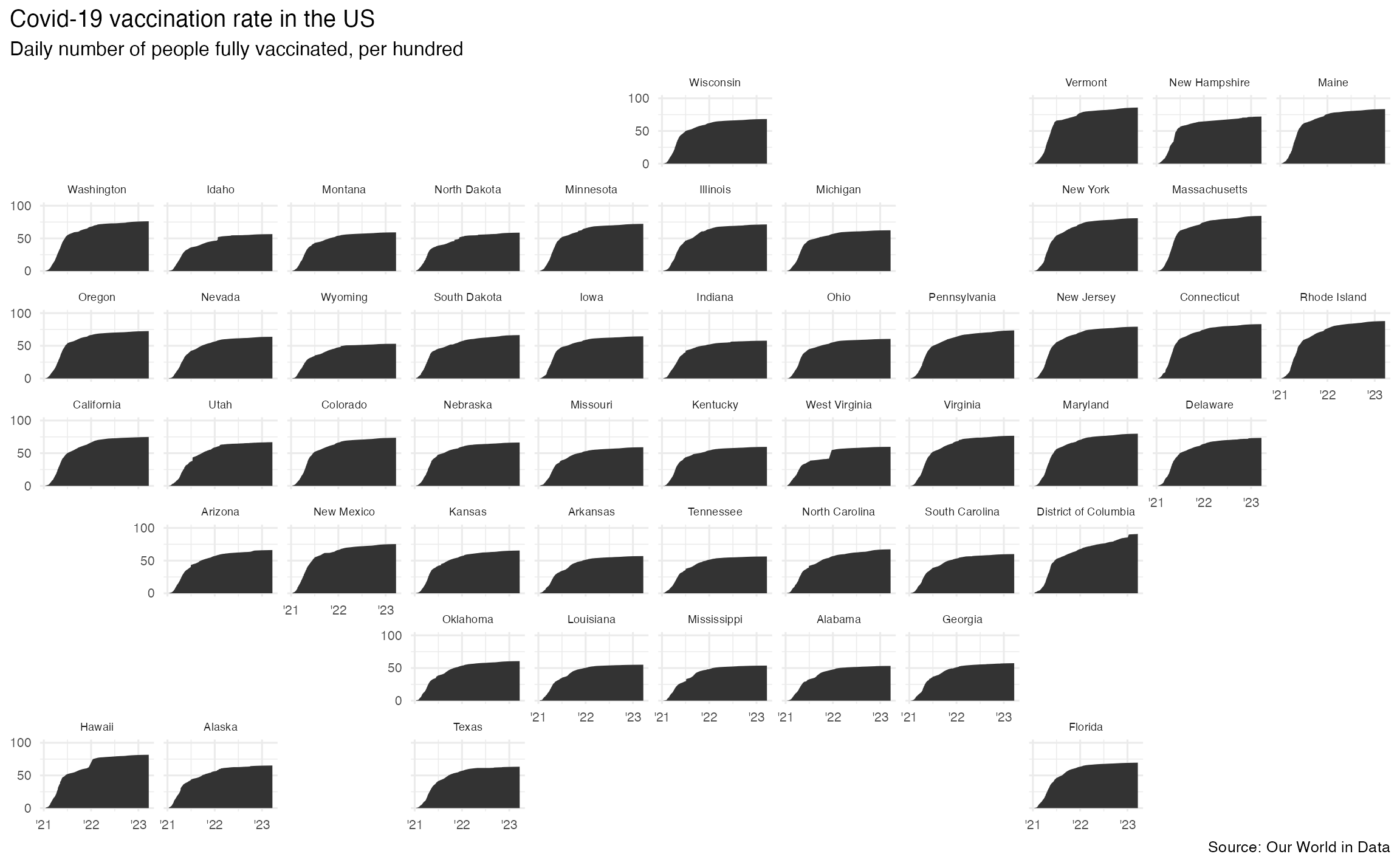Visualizing spatial data I
Lecture 13
Dr. Benjamin Soltoff
Cornell University
INFO 3312/5312 - Spring 2025
March 12, 2024
Announcements
Announcements
- Homework 04
- Project 02
Visualization critique
A review of executions in the United States
Geospatial visualizations
Geospatial visualizations
- Earliest form of information visualizations
- Geospatial data visualizations
- Google Maps
Not that Jon Snow

Dr. John Snow
Designing modern maps
- Depict spatial features
- Incorporate additional attributes and information
- Major features
- Scale
- Projection
- Symbols
Scale
- Proportion between distances and sizes on a map and their actual distances and sizes on Earth
- Small-scale map
- Large-scale map
Large-scale map

Small-scale map

Asgard
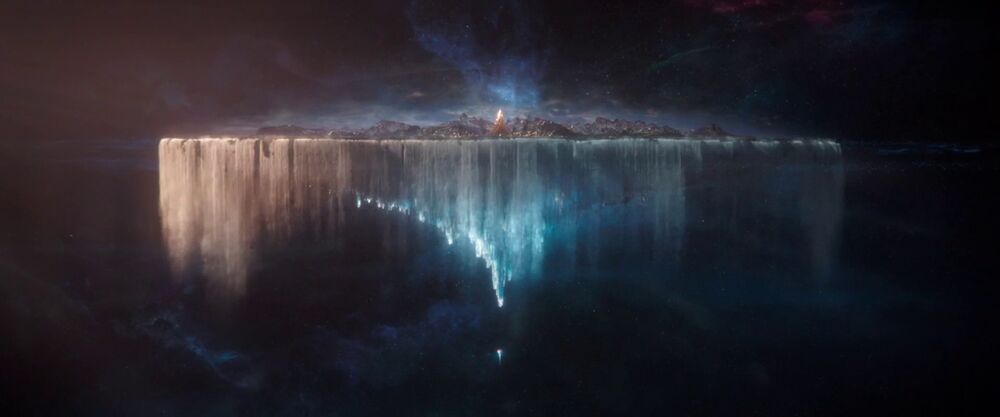
Midgard
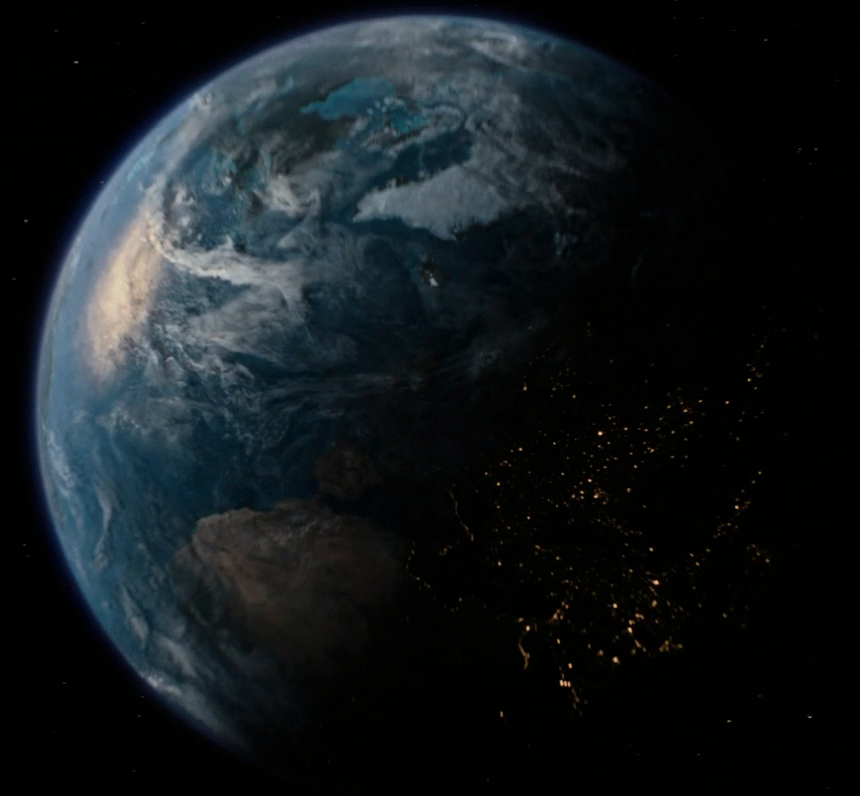
Not flat
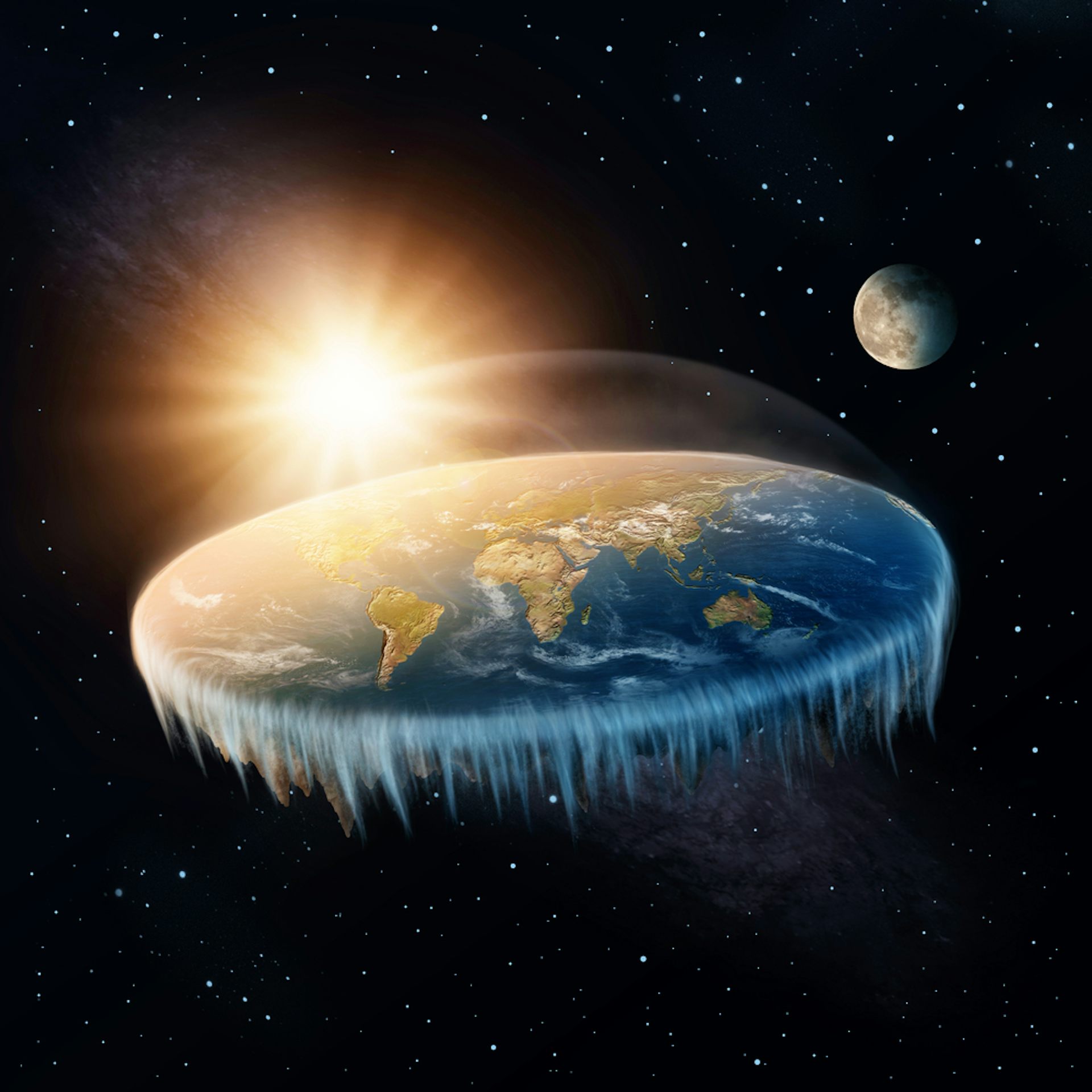
Projection
- Process of taking a three-dimensional object and visualizing it on a two-dimensional surface
- No 100% perfect method for this
- Always introduces distortions
Properties of projection methods
- Shape
- Area
- Angles
- Distance
- Direction

Symbols

ggmap for raster maps
ggmap
- Package for drawing maps using {ggplot2} and raster map tiles
- Static image files generated by mapping services
- Focus on incorporating data into existing maps
- Severely limits ability to change the appearance of the geographic map
- Don’t have to worry about the maps, just the data to go on top
Bounding box
Level of detail

Identifying bounding box
Use bboxfinder.com to determine the exact longitude/latitude coordinates for the bounding box you wish to obtain.
Types of map tiles


Import crime data
- New York City open data portal
- Crime data from 2022
Rows: 256,797
Columns: 7
$ cmplnt_num <chr> "247350382", "243724728", "246348713", "240025455", "2461…
$ boro_nm <chr> "BROOKLYN", "QUEENS", "QUEENS", "BROOKLYN", "BRONX", "BRO…
$ cmplnt_fr_dt <dttm> 1011-05-18 04:56:02, 1022-04-11 04:56:02, 1022-06-08 04:…
$ law_cat_cd <chr> "MISDEMEANOR", "MISDEMEANOR", "MISDEMEANOR", "FELONY", "F…
$ ofns_desc <chr> "CRIMINAL MISCHIEF & RELATED OF", "PETIT LARCENY", "PETIT…
$ latitude <dbl> 40.66904, 40.77080, 40.68766, 40.65421, 40.83448, 40.6973…
$ longitude <dbl> -73.90619, -73.81115, -73.83406, -73.95957, -73.85637, -7…Plot high-level map of crime
Using geom_point()
Using geom_point()
Using geom_density_2d()
Using stat_density_2d()
Using stat_density_2d()
Looking for variation
ggmap(nyc) +
stat_density_2d(
data = crimes |>
filter(ofns_desc %in% c(
"DANGEROUS DRUGS",
"GRAND LARCENY OF MOTOR VEHICLE",
"ROBBERY",
"VEHICLE AND TRAFFIC LAWS"
)),
aes(
x = longitude,
y = latitude,
fill = after_stat(level)
),
alpha = .4,
bins = 10,
geom = "polygon"
) +
facet_wrap(facets = vars(ofns_desc))
Application exercise
ae-10
- Go to the course GitHub org and find your
ae-10(repo name will be suffixed with your NetID). - Clone the repo in RStudio Workbench, open the Quarto document in the repo, and follow along and complete the exercises.
- Render, commit, and push your edits by the AE deadline – end of tomorrow.
Geofaceting and cartograms
ggplot(us_state_vaccinations, aes(x = date, y = people_fully_vaccinated_per_hundred, group = location)) +
geom_area() +
facet_geo(facets = vars(location)) +
scale_y_continuous(
limits = c(0, 100),
breaks = c(0, 50, 100),
minor_breaks = c(25, 75)
) +
scale_x_date(breaks = c(ymd("2021-01-01", "2022-01-01", "2023-01-01")), labels = c("'21", "'22", "'23")) +
labs(
x = NULL, y = NULL,
title = "Covid-19 vaccination rate in the US",
subtitle = "Daily number of people fully vaccinated, per hundred",
caption = "Source: Our World in Data"
) +
theme(
strip.text.x = element_text(size = 7),
axis.text = element_text(size = 8),
plot.title.position = "plot"
)Daily US vaccine data by state
Rows: 51,492
Columns: 16
$ date <date> 2021-01-12, 2021-01-13, 2021-01-1…
$ location <chr> "Alabama", "Alabama", "Alabama", "…
$ total_vaccinations <dbl> 78134, 84040, 92300, 100567, NA, N…
$ total_distributed <dbl> 377025, 378975, 435350, 444650, NA…
$ people_vaccinated <dbl> 70861, 74792, 80480, 86956, NA, NA…
$ people_fully_vaccinated_per_hundred <dbl> 0.15, 0.19, NA, 0.28, NA, NA, NA, …
$ total_vaccinations_per_hundred <dbl> 1.59, 1.71, 1.88, 2.05, NA, NA, NA…
$ people_fully_vaccinated <dbl> 7270, 9245, NA, 13488, NA, NA, NA,…
$ people_vaccinated_per_hundred <dbl> 1.45, 1.53, 1.64, 1.77, NA, NA, NA…
$ distributed_per_hundred <dbl> 7.69, 7.73, 8.88, 9.07, NA, NA, NA…
$ daily_vaccinations_raw <dbl> NA, 5906, 8260, 8267, NA, NA, NA, …
$ daily_vaccinations <dbl> NA, 5906, 7083, 7478, 7498, 7509, …
$ daily_vaccinations_per_million <dbl> NA, 1205, 1445, 1525, 1529, 1531, …
$ share_doses_used <dbl> 0.207, 0.222, 0.212, 0.226, NA, NA…
$ total_boosters <dbl> NA, NA, NA, NA, NA, NA, NA, NA, NA…
$ total_boosters_per_hundred <dbl> NA, NA, NA, NA, NA, NA, NA, NA, NA…Facet by location
Data cleaning
Geofacet by state
Using geofacet::facet_geo():

ggplot(
data = us_state_vaccinations,
mapping = aes(x = date, y = people_fully_vaccinated_per_hundred)
) +
geom_area() +
facet_geo(facets = vars(location)) +
labs(
x = NULL, y = NULL,
title = "Covid-19 vaccination rate in the US",
subtitle = "Daily number of people fully vaccinated, per hundred",
caption = "Source: Our World in Data"
)Geofacet by state, with improvements

ggplot(us_state_vaccinations, aes(x = date, y = people_fully_vaccinated_per_hundred, group = location)) +
geom_area() +
facet_geo(facets = vars(location)) +
scale_y_continuous(
limits = c(0, 100),
breaks = c(0, 50, 100),
minor_breaks = c(25, 75)
) +
scale_x_date(breaks = c(ymd("2021-01-01", "2022-01-01", "2023-01-01")), labels = c("'21", "'22", "'23")) +
labs(
x = NULL, y = NULL,
title = "Covid-19 vaccination rate in the US",
subtitle = "Daily number of people fully vaccinated, per hundred",
caption = "Source: Our World in Data"
) +
theme(
strip.text.x = element_text(size = 7),
axis.text = element_text(size = 8),
plot.title.position = "plot"
)Bring in 2020 Presidential election results
# A tibble: 51 × 5
state electoal_votes biden trump win
<chr> <dbl> <dbl> <dbl> <chr>
1 Alabama 9 0 9 Republican
2 Alaska 3 0 3 Republican
3 Arizona 11 11 0 Democrat
4 Arkansas 6 0 6 Republican
5 California 55 55 0 Democrat
6 Colorado 9 9 0 Democrat
7 Connecticut 7 7 0 Democrat
8 Delaware 3 3 0 Democrat
9 District of Columbia 3 3 0 Democrat
10 Florida 29 0 29 Republican
# ℹ 41 more rowsGeofacet by state, color by presidential election result
us_state_vaccinations |>
left_join(election_2020, by = c("location" = "state")) |>
ggplot(mapping = aes(x = date, y = people_fully_vaccinated_per_hundred)) +
geom_area(mapping = aes(fill = win)) +
facet_geo(facets = vars(location)) +
scale_y_continuous(limits = c(0, 100), breaks = c(0, 50, 100), minor_breaks = c(25, 75)) +
scale_x_date(breaks = c(ymd("2021-01-01", "2022-01-01", "2023-01-01")), labels = c("'21", "'22", "'23")) +
scale_fill_manual(values = c("#2D69A1", "#BD3028")) +
labs(
x = NULL, y = NULL,
title = "Covid-19 vaccination rate in the US",
subtitle = "Daily number of people fully vaccinated, per hundred",
caption = "Source: Our World in Data",
fill = "2020 Presidential\nElection"
) +
theme(
strip.text.x = element_text(size = 7),
axis.text = element_text(size = 8),
plot.title.position = "plot",
legend.position = c(0.93, 0.15),
legend.text = element_text(size = 9),
legend.title = element_text(size = 11),
legend.background = element_rect(color = "gray", size = 0.5)
)Wrap-up
Wrap-up
- Modern geospatial visualizations are defined by their scale, project, and symbols
- ggmap allows you to create geospatial visualizations without needing to collect the spatial features directly
- geofacet allows you to create cartograms which incorporate geographic location
The end of an era

